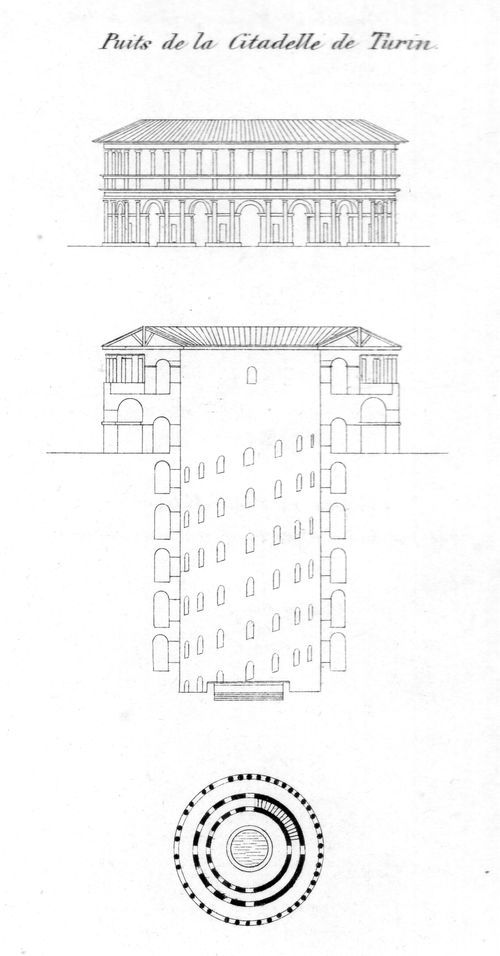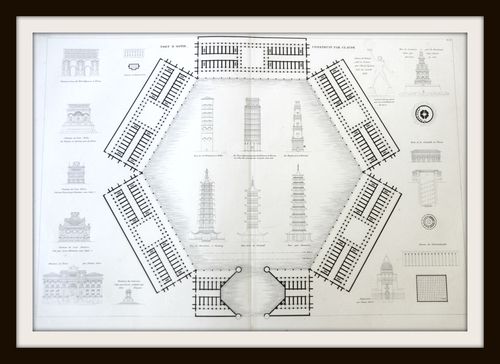JF Ptak Science Books Post 2483
As M. Chabat writes,"Considérés au point de vue de la forme et de l'ornementation extérieures un grand nombre de puits de toutes les époques peuvent être regardés comme de véritables œuvres d'art...", which is certainly true of the well at the citadel of Turin--even the elevation and (particularly) the plan of the structure.
 Funny that this is what I find most interesting in this big engraved sheet from Jean Nicolas Louis Durand's monumental and important semi-biblical work on the history of architecture, but, so it goes. (The work is Recueil et Parallele des Edifices, and was printed in Venice by Giuseppe Antonelli in Venice in 1833; it comes some 31 years after the appearance of the first edition, greatly expanded, with 273 plates compared to 90 in the first.)
Funny that this is what I find most interesting in this big engraved sheet from Jean Nicolas Louis Durand's monumental and important semi-biblical work on the history of architecture, but, so it goes. (The work is Recueil et Parallele des Edifices, and was printed in Venice by Giuseppe Antonelli in Venice in 1833; it comes some 31 years after the appearance of the first edition, greatly expanded, with 273 plates compared to 90 in the first.)
- The original engraving is available for sale at the blog's bookstore, here.
There's plenty on this sheet worthy of attention--and as the Durand work is concerned, it is one of the few to feature towers. And in the case of the Turin well, it may be considered (here at least and not probably by anyone who knows anything at all about architecture) to be a reverse tower. This is slim pickin's so far as engineering reasoning goes--or is it? Why if it was so removed from logic would the considerable and considered Durant include the thing on his page of towers?
One of the remarkable points on this structure was the dual circular staircases that would allow the horses hauling water from the depths for go up and down without having to pass on another.
The other thing about Durand was that his work is considered a great scientific improvement in the description of architecture, and seems to me to be the first work to compare different sorts of buildings (and from different periods) all in the same scale, on pone piece of paper, side-by-side. It seems that in the history of formalization and categorization and classification that this business of comparative architecture that someone would have used a single standard of description for size--but evidently not.
- See here for an interesting appraisal of Durand along with 90 links for each of the images of the first edition. (Quandom.com)
"Le puits de la citadelle de Turin dont la fig 2413 représente la coupe et le plan à une échelle moitié moindre est établi dans les mêmes conditions. On ne saurait oublier de citer également le puits de Bicétre près de Paris achevé en 1735 d après les plans de Boffrand et qui a 57 mètres de profondeur sur 3 mètrrs de largeur L eau s en extrait au moyen de deux seaux contenant chacun près de 270 litres d eau et pesant 600 kilogrammes lesquels montent et descendent ù l aide d une charpente tournante mue par 8 chevaux cette eau est reçue dans un réservoir d où elle est distribuée par des conduits dans les diverses parties de l établissement. Considérés au point de vue de la forme et de l ornementation extérieures un grand nombre de puits de toutes les époques peuvent être regardés comme de véritables œuvres d'art..." Dictionnaire des termes employés dans la construction ...: volume G.-Z, by Pierre Chabat, 1872




Comments